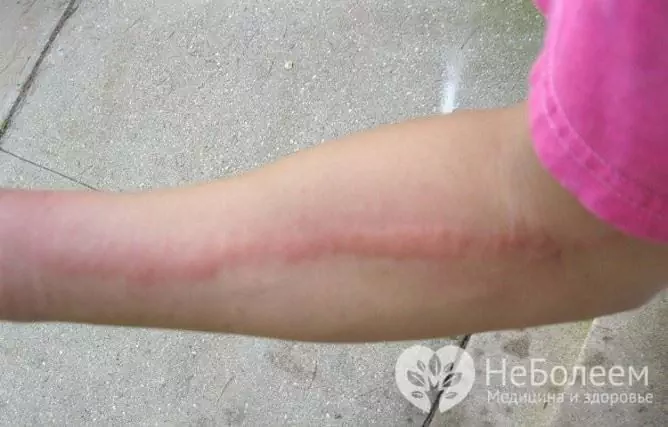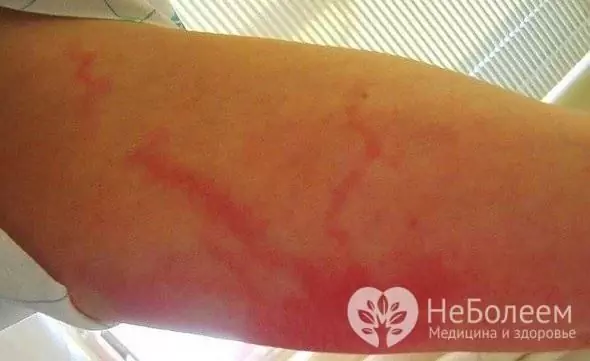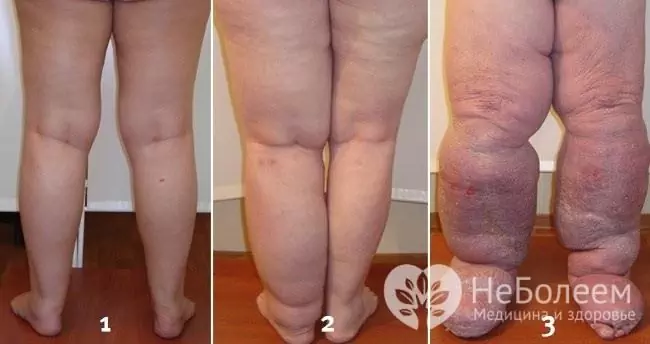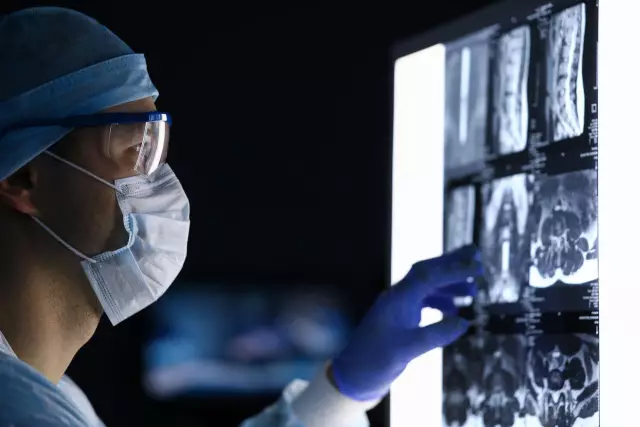- Author Rachel Wainwright [email protected].
- Public 2023-12-15 07:39.
- Last modified 2025-11-02 20:14.
Lymphangitis
The content of the article:
- Causes and risk factors
- Forms of the disease
- Lymphangitis symptoms
- Diagnostics
- Lymphangitis treatment
- Potential consequences and complications
- Forecast
- Prevention
Lymphangitis (lymphangitis, lymphangitis) is an acute or chronic inflammation of the lymphatic vessels caused by pathogenic microflora. The pathological process can affect vessels of various localization, depth and caliber, however, in clinical practice, lymphangitis of the extremities is more common, which is associated with the peculiarities of lymph circulation, as well as their more frequent injury.

Source: gidmed.com
Causes and risk factors
The causative agents of lymphangitis are staphylococci, β-hemolytic streptococcus, Escherichia coli, Proteus and other aerobic bacteria or their associations. The infection enters the lymphatic vessels from the primary focus (infected wound, abrasion, abscess, furuncle, carbuncle or phlegmon).
The likelihood of developing inflammation of the lymphatic vessels depends on the size and localization of the primary focus of infection, the characteristics of lymph flow in a given area of the body, and the virulence of the pathogen.
Infectious agents cause damage to the lymphatic vessel wall, which leads to an increase in its permeability, sweating of lymph into the interstitial space, endothelial edema and the formation of intravascular thrombi. The described changes cause lymphostasis, i.e., lymph stagnation. With the further progression of the infectious process, purulent fusion of the thrombus and the walls of the lymphatic vessel occurs - purulent lymphangitis develops.
In the absence of the necessary treatment, the infection spreads to the tissues surrounding the affected lymphatic vessel (muscles, joints, blood vessels), which indicates the development of perilymphangitis.
In severe lymphangitis, the infection can be ascending and spread to the thoracic lymphatic duct.
If the patient has tuberculosis, specific tuberculous lymphangitis may form. Sexually transmitted infections (urethritis, genital herpes, primary syphilis) cause specific venereal lymphangitis.
In the practice of urologists, lymphangitis of the penis occurs, caused by injury to the penis during prolonged intercourse or intense masturbation. Another name for this condition is non-venereal lymphangitis.
Forms of the disease
According to the features of the clinical course, lymphangitis is divided into:
- acute - usually occurs near a superficially located focus of purulent infection, pathological changes with it progress rapidly;
- chronic - lasts a long time; there is a blockage of deeply located lymphatic vessels, which leads to severe swelling of the limbs.
Depending on the existing pathomorphological changes, there are:
- serous lymphangitis - infiltration of soft tissues along the affected lymphatic vessel with serous inflammatory exudate is noted;
- purulent lymphangitis - purulent fusion of the walls of the affected lymphatic vessel occurs, as well as the formation of phlegmons, abscesses along its course;
- reticular lymphangitis - is observed when small lymphatic vessels are affected and is characterized by pronounced hyperemia of the skin in the form of thin stripes extending from the focus of inflammation to the nearest lymph nodes.
Depending on the caliber of the affected vessels, lymphangitis is isolated:
- capillary (reticular, reticular) - many superficial lymphatic capillaries are inflamed;
- truncular (stem) - 1-2 large stem lymphatic vessels are affected.

Depending on the depth of the inflamed vessels:
- superficial lymphangitis;
- deep.
Lymphangitis symptoms
Acute lymphangitis is always accompanied by a pronounced intoxication syndrome. Its symptoms:
- headache;
- severe weakness;
- excessive sweating;
- an increase in temperature to 39-40 ° C, accompanied by severe chills;
- arthralgia and myalgia;
- lack of appetite.
With capillary lymphangitis around the focus of primary infection (wound, trophic ulcer, abscess), there is a pronounced hyperemia of the skin with an enhanced marble (mesh) pattern. According to the clinical course, the process resembles erysipelas, but the focus of hyperemia has blurred boundaries, which is not typical for erysipelas.
The local manifestation of stem lymphangitis is the appearance on the skin of a bright red strand, stretching from the focus of purulent inflammation along the lymphatic vessel to the nearest lymph nodes. The tightness quickly becomes painful and indurated, and the surrounding soft tissues swell. When it is palpated, the symptom is clear (the presence of painful seals). In patients, regional lymphadenitis occurs and rapidly progresses.
With deep lymphangitis, local hyperemia is not observed. Pain appears in the affected limb, which sharply increases with movement or deep palpation. Lymphedema develops - a pronounced edema of the affected limb, caused by blockage of a large lymphatic vessel and impaired lymph outflow.
The clinical picture of chronic lymphangitis is erased. Characterized by edema of the extremity associated with disorders of lymph circulation and lymphostasis.
With non-venereal lymphangitis of the penis, a compacted painless cord appears along its coronal groove or trunk. It lasts from several hours to several days, and then disappears on its own.
Diagnostics
Superficial lymphangitis usually does not cause diagnostic difficulties. However, in some cases, the disease requires differential diagnosis with superficial vein thrombophlebitis and erysipelas. Identification of the primary inflammatory focus helps to make the correct diagnosis.
The diagnosis of deep lymphangitis is somewhat more difficult. In this case, it is necessary to take into account the data of the anamnesis and clinical symptoms, the results of laboratory and instrumental studies. The survey design includes:
- general blood test - leukocytosis is detected with a shift of the leukocyte formula to the left;
- bacteriological examination of a purulent wound discharge - allows you to identify the causative agent of the disease, as well as determine its sensitivity to antibiotics;
- Doppler ultrasound of lymphatic vessels - narrowing of the lumen, heterogeneity of the structure, the presence of a hyperechoic rim around the affected vessel, reactive changes in regional lymph nodes;
- computer thermography - makes it possible to assess the depth and prevalence of the pathological process, its severity.
If complications of purulent lymphangitis occur, a blood test for sterility is shown.
Lymphangitis treatment
In acute lymphangitis, treatment is aimed at eliminating the primary infectious focus (opening of panaritiums, abscesses, phlegmon followed by drainage of the purulent cavity, surgical treatment of the wound). The patient is shown bed rest. The affected limb is fixed in an elevated position, which improves the outflow of lymph. In the diet, the content of table salt is limited (no more than 6 g per day). Massage, thermal procedures and active rubbing of ointments are unacceptable.
Drug therapy for acute lymphangitis includes the appointment of antibiotics (lincosamides, aminoglycosides, cephalosporins, semi-synthetic penicillins), antihistamines and anti-inflammatory drugs. To combat intoxication, infusion therapy is performed. Ultraviolet (UFOK) and laser (ILBI) irradiation of blood have a good therapeutic effect.
With specific venereal lymphangitis caused by a sexually transmitted disease, antibiotic therapy is performed.
With chronic sluggish lymphangitis, patients are prescribed compresses with dimethyl sulfoxide or semi-alcoholic, ointment dressings, ultraviolet irradiation of the affected limb, mud therapy. In cases where the disease is persistent, the question of the appropriateness of X-ray therapy is considered.
Non-venereal lymphangitis does not require treatment.
Potential consequences and complications
With purulent lymphangitis and the spread of infection to the surrounding soft tissues, their purulent fusion may develop with the formation of abscesses and phlegmon. Untimely opening of purulent formations can lead to sepsis.
Against the background of a long course of chronic lymphangitis, a gradual obliteration of the affected lymphatic vessels occurs with the development of lymphostasis, and later on elephantiasis.

Forecast
In most cases, with timely and adequate treatment, the prognosis is favorable.
Prevention
Prevention of lymphangitis is based on the following measures:
- timely surgical treatment of deep wounds;
- adequate antibiotic therapy for infectious and inflammatory diseases;
- sanitation of foci of purulent infection.
YouTube video related to the article:

Elena Minkina Doctor anesthesiologist-resuscitator About the author
Education: graduated from the Tashkent State Medical Institute, specializing in general medicine in 1991. Repeatedly passed refresher courses.
Work experience: anesthesiologist-resuscitator of the city maternity complex, resuscitator of the hemodialysis department.
The information is generalized and provided for informational purposes only. At the first sign of illness, see your doctor. Self-medication is hazardous to health!






